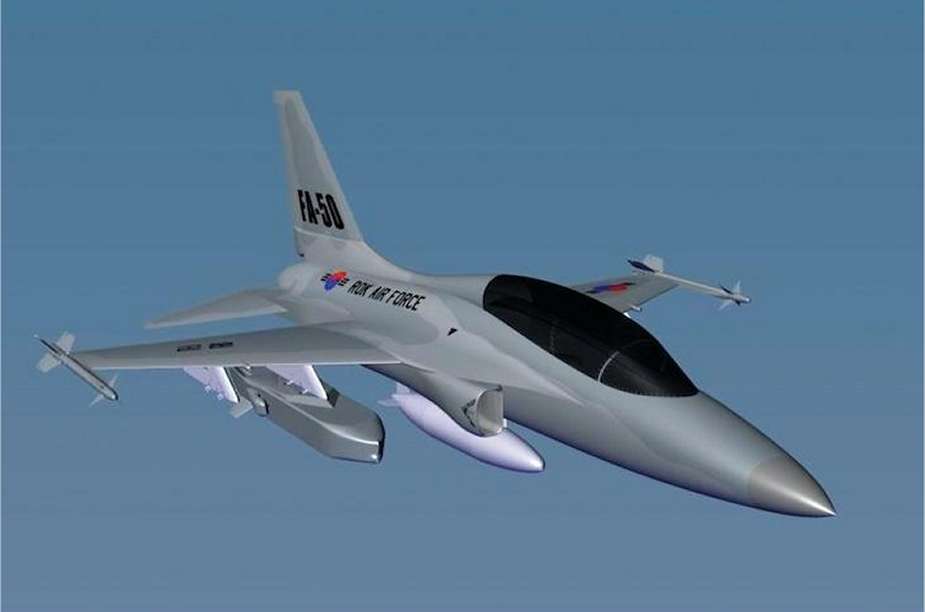The South Korean fighter aircraft F/A-50 is set to be equipped with a compact version of the Taurus cruise missile. Currently, the South Korean Air Force possesses the KEPD 350 Taurus cruise missiles, exclusively intended for its F-15K fighter-bombers.
Follow Air Recognition on Google News at this link
 The South Korean fighter aircraft F/A-50 is set to be equipped with a compact version of the Taurus cruise missile. (Picture source: Open Source)
The South Korean fighter aircraft F/A-50 is set to be equipped with a compact version of the Taurus cruise missile. (Picture source: Open Source)
In December 2022, the South Korean Defense Agency (DAPA) allocated significant funding for the development of an air-to-ground cruise missile as part of the KALCM (Korean Air Launched Cruise Missile) program, entrusted to LIG Nex1 and Hanwha Aerospace. This missile is intended for the future KF-21 Boramae combat aircraft, with serial production expected to begin this year. It will be the primary strategic component of South Korea's deterrence system, especially under the KMPR (Korea Massive Punishment & Retaliation) framework for potential massive retaliation in case of conflict.
However, Taurus Systems GmbH, a joint subsidiary of MBDA Deutschland and Saab Dynamics AB, has signed an agreement with LIG Nex1 to develop a more compact version of the KEPD 350 Taurus missile, known as the KEPD 350K2. This initiative primarily aims to promote the export of the F/A-50 "Golden Eagle" aircraft produced by Korea Aerospace Industries (KAI).
The development of this new version of the Taurus missile is progressing rapidly. Christopher Drevstad, President of Taurus Systems Korea Co., recently announced that the preliminary development phase of the KEPD 350K2 is almost complete. The KEPD 350K-2 is expected to have similar performance to its predecessor, but it will be smaller, with a mass of approximately 900 kg (compared to 1400 kg for the Taurus). It will also be shorter by about sixty centimeters. This variant, adapted for the F/A-50, will maintain a range of 500 km and nearly identical capabilities thanks to the use of independent navigation systems resistant to GPS jamming.
The F/A-50, also known as the T-50 Golden Eagle, is a versatile aircraft of South Korean origin designed to fulfill multiple roles within air forces. It is manufactured by Korea Aerospace Industries (KAI) in collaboration with Lockheed Martin. The T-50 was initially developed as an advanced trainer aircraft, with its maiden flight taking place on August 20, 2002, marking the beginning of its development.
This versatile aircraft comes in several versions, including the T-50, primarily used as an advanced trainer aircraft, the TA-50, serving as an advanced combat trainer, and the FA-50, which is the light combat aircraft version. The FA-50 was introduced into service on February 22, 2005, and is currently in use in several countries.
The F/A-50 is a versatile aircraft that can be used for a variety of missions, including advanced pilot training, combat training, and even light aerial combat missions. It is used by the Republic of Korea Air Force, as well as by other air forces around the world, including the Iraqi Air Force, the Indonesian Air Force, and the Philippine Air Force.
Since the start of production in 2001, approximately 200 units of all T-50 versions have been built. The F/A-50 represents a significant contribution from the South Korean aerospace industry on the international stage, demonstrating its ability to produce high-quality aircraft for diverse roles within air forces.
As the KF-21/KALCM system is yet to be deployed, the South Korean Air Force may be interested in the KEPD 350K-2 as it would reduce the risk associated with using Taurus missiles on a single platform. This option would be particularly relevant, given that the sixty F-15K aircraft currently in service are set to undergo expensive modernization between 2024 and 2034, estimated at 2.3 billion euros. The integration of these missiles on a secondary or even a third platform would be a viable security measure, according to Mr. Drevstad.
















